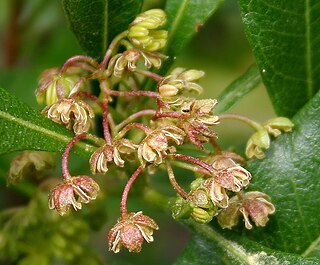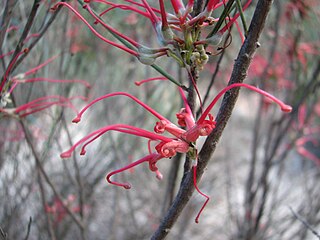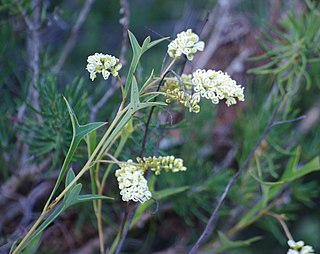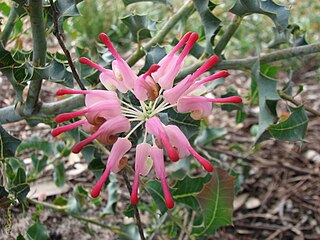
Ptelea is a genus of flowering plants in the citrus family, Rutaceae. The name, of Greek derivation, is the classical name of the elm tree. Carl Linnaeus used that word for this genus because of the resemblance of its fruit to that of the elm. Members of the genus are commonly known as hoptrees.

Dodonaea viscosa is a species of flowering plant in the soapberry family, Sapindaceae, that has a cosmopolitan distribution in tropical, subtropical and warm temperate regions of Africa, the Americas, southern Asia and Australasia.

Dodonaea is a genus of about 70 species of flowering plants, often known as hop-bushes, in the soapberry family, Sapindaceae. It has a cosmopolitan distribution in tropical, subtropical and warm temperate regions of Africa, the Americas, southern Asia and Australasia. By far the highest species diversity is in Australia. The genus is named after Rembert Dodoens, traditionally known as 'Dodonaeus'.

Woody Island is an island off the south coast in the Goldfields-Esperance region of Western Australia.

Anthocercis, commonly known as tailflower, is a genus of shrubs which are endemic to southern temperate Australia with the center of distribution in the South West Botanical Province of Western Australia. All species of Anthocercis contain tropane alkaloids, and have occasionally caused poisoning in children or suspected of poisoning stock. Anthocercis is known as the only Solanaceous plant known to produce resin compounds on glandular trichomes.

Grevillea pilosa is a low growing shrub which is endemic to the south-west of Western Australia. It grows to between 0.4 and 1 metre in height and produce red or pink flowers between June and December in its native range.

Banksia laevigata subsp. fuscolutea is a subspecies of Banksia laevigata. It is native to the Southwest Botanical Province of Western Australia.
Banksia meisneri subsp. meisneri is a subspecies of Banksia meisneri. It is native to the Southwest Botanical Province of Western Australia. As an autonym, it is defined as containing the type specimen of the species.

Grevillea didymobotrya is a shrub in the family Proteaceae. It is endemic to south-western Western Australia.

Grevillea montis-cole is a shrub which is endemic to central-western Victoria, Australia. It has similarities in appearance to Grevillea microstegia, Grevillea floripendula and Grevillea aquifolium but has larger floral bracts. The flowers, which appear between October and March in its native range, have greenish to fawn perianths and red styles.

Grevillea sarissa, the wheel grevillea, is a shrub which is native to South Australia and Western Australia. It grows to between 0.6 and 3.5 metres in height and produces yellow, red or pink flowers between August and December in its native range.

Grevillea synapheae, the catkin grevillea, is a shrub in the family Proteaceae. It is endemic to the southwest of Western Australia, occurring in low heathland.

Adenanthos pungens, the spiky adenanthos, is a species of shrub in the family Proteaceae. It is endemic to the south-west of Western Australia.

Grevillea diversifolia, the variable-leaved grevillea, is a shrub in the family Proteaceae. It is endemic to the south-west of Western Australia. It has an erect or spreading shrub habit, growing to between 1 and 5 metres in height and has a peak flowering period between July and October in its native range.

Dittrichia viscosa, also known as false yellowhead, woody fleabane, sticky fleabane and yellow fleabane, is a flowering plant in the daisy family.

Grevillea ilicifolia, commonly known as holly grevillea, is a species of the plant genus Grevillea. It is a shrub of variable form, growing to between 0.3 and 2 metres in height and 3 metres wide. Typically, leaves are lobed and holly like, but may also be unlobed. The flowers have perianths that have a base that is cream to green grading to grey-mauve. Styles may be pink, red, orange or yellow. The main flowering period in the species' native range is September to November.

Anthocercis littorea, also known as yellow tailflower, is a species of shrub in the family Solanaceae. It's native to Western Australia where it grows on coastal limestone and dunes as well as sandplains. It usually grows to between 0.6 and 3 metres in height and produces yellow flowers throughout the year in its native range.

Grevillea insignis, commonly known as wax grevillea, is a shrub species which is endemic to the south-west of Western Australia. The species was first formally described in 1855 in Hooker's Journal of Botany and Kew Garden Miscellany.

Grevillea refracta, commonly known as the silver-leaf grevillea, is a species of plant in the protea family that is native to northern Australia.
Anthocercis gracilis, also known as slender tailflower, is a rare species of shrub in the family Solanaceae. It is native to Western Australia where it grows on sandy or loamy soils, and on granite outcrops. It is a spindly, erect shrub which can grow to 1 m high. Its yellow-green flowers may be seen from September to October.


















